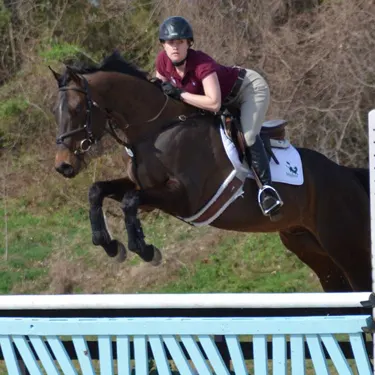Trust the process.
There’s a certain lightness, a space somewhere between leaving the ground and landing when you can feel your young horse begin to understand how to use his parts well and truly jump. His withers arc up underneath you, and out of the corner of your eye you might just see his knees. It’s a feeling that’s difficult to describe in words, so I find myself using sounds, like “pa-pow!”
And it’s not the spooky jump—that leap and scatter that frequently accompanies teaching a young horse. It’s a relaxed, reflexive arc that evolves out of a good canter to the base. That’s what makes my heart beat faster, that’s what all the hard work is all about: creating that quality of jump.
Yes, some of them are naturals. They come out of the box putting their parts in all the right places. But most of them are not. The Thoroughbred horses I ride were not bred to jump. They were bred to run fast in a straight line and maybe fly over the occasional hurdle in survival mode at 640,978,405 m.p.h.
For me, teaching a horse to jump is more than teaching him to go through the flags. It’s teaching him to do it properly, and that is a process. To train them and train them well, you have to trust the process. You must subscribe to a system and be consistent. There are many different methodologies all aiming at the same goal: a quality jump and a rideable horse. But I can guarantee you none of them have a footnote that says, “Skip steps 2-99 and expect your horse to cart you around the show ring.” It’s all about the process.
ADVERTISEMENT
And no, the process isn’t some set-in-stone rigid framework that the horses are forced to operate in. It’s a fluid system that constantly reinforces rideability and technique, on their part and on mine, whether that be through lateral work on the flat, a gymnastic or quietly walking on the trail. The horse show is not the end result of the process but yet another step on the path to rideability. Competition provides more variables to the equation: nerves, new environment, general chaos, etc, etc. And part of training young horses well is being able to adapt your expectations to the horse’s ability to meet them on that day.
I recently took a few of my greenest horses for two consecutive weeks of competition. They started out the first week wide-eyed and a little worried, but over the following 14 days they each improved at their own rate. I was reminded of the fact that progress in a horse’s training is not always linear. It doesn’t follow a set mathematical curve; it is always changing, evolving and indefinite.
This point was proven to me over and over again during those two weeks. Though the progress our horses make isn’t always constant or obvious, the process we use to effect that progress must be. While I was in the warm-up area, my trainer pointed out another rider who was working his horse on the flat. My trainer asked me, “What’s he getting ready for?” I replied, “This class?” My trainer said, “No, he just went. He’s getting ready for tomorrow.”
That’s what we should all be doing, every day, getting ready for tomorrow. Because, in truth, we are never done training. And if we live by that rule and trust in the process every day, every ride, you might find that your seemingly flat line of progress begins to arc upward exponentially.
Hunter/jumper trainer Paige Cade works at Tebogo Sport Horses, a facility in Delaplane, Va., devoted to the re-training and sales of off-the-track Thoroughbreds.















